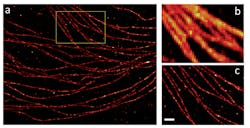Optical microscopy provides an unmatched ability to generate images of live cells that map content, local environment, and function. However, diffraction historically limited microscopy to spatial resolution >200 microns. That all changed with the development of super-resolution techniques, with resolution as fine as 20 nm and even less. These diverse approaches all rely on switching the state (dark/light) of a fluorescent probe. Techniques like STORM and fPALM rely on random stochastic switching, whereas techniques like STED and RESOLFT rely on using a second laser beam to deterministically switch probes in a pre-defined pattern.
Optimized laser fluorescence images rely on matching a laser to the application as discussed in general terms here. All these super-resolution methods have a common requirement for a low-noise laser with a wavelength that matches the absorption of the fluorophore being used. However, the optimum power and modulation requirements are very technique-specific.
Fortunately, a single technology, called the Optically Pumped Semiconductor Laser (OPSL), can provide a comprehensive range of laser models that deliver optimum performance for all these super-resolution techniques. That’s because the OPSL is the only visible laser technology that is both wavelength and power scalable, and produces the requisite beam quality. This enables Coherent to provide OPSLs across a wide spectral range with powers from milliwatts to tens of watts.
One of many examples that illustrate the advantages of tailoring the wavelength and power uses a laser from the Coherent Genesis series. Specifically, the laboratory of Professor Zhen-li Huang at Wuhan National Laboratory for Optoelectronics, China has recently used a 3 watt model with yellow output at 561 nm with direct modulation to successfully address the slow speed limitation of STORM. The high laser power enabled a 10X increase in the field of view and thereby reduced the overall image acquisition time, with no loss of resolution.
Figure 1. Examples of STORM (a,c) and normal (b) images from Professor Huang showing 40 nanometer resolution. Scale bar: 500 nm.

